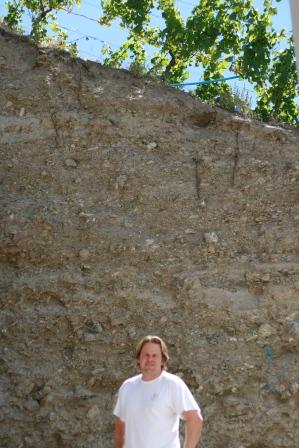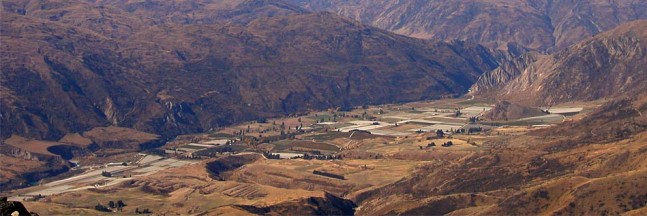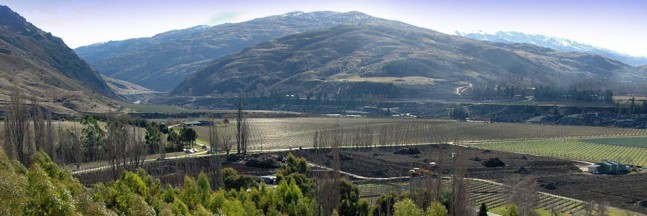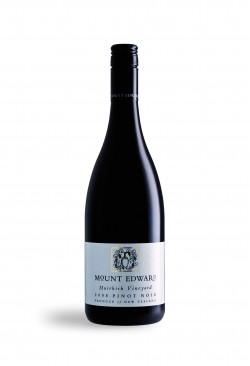3 Individual Vineyard Cuvees from the 2009 Vintage:
Morrison Vineyard – Lowburn
Muirkirk Pinot Noir – Bannockburn
Stevens Vineyard – Gibbston
As I begin to write this, deep reflection invades my thoughts as the evolution of the Central Otago wine region is homogenous with my own wine career; a parallel of timeline more than actual vocation as I am not a vigneron, more an ancillary to the endeavours of the pioneers of this region. As a sommelier and subsequently a wine importer and merchant in Australia, I felt equally absorbed in this venture, nurturing, sharing the challenges and successes as they unfolded and Central Otago metamorphosed.
My first visit to Central Otago wine country was in the early 90s and like anyone who travels through this region, was awestruck by the rugged beauty of precipitous mountains, serpentine gorges, undulating valleys and loamy terraces. It was nearing the end of winter with snow still blanketing everything almost down to the roadside, yet brilliantly sunny with impossibly blue skies.
Growing up in New Zealand, I am no stranger to this exhilarating native wilderness; trekking, fishing, hunting and even braving the wildest extremes of Lake Tekapo and the South Island high country in winter and yet as I travelled through Central Otago, it seemed so much more captivating, in a beguiling way.
I guess my head was in another place in my youth and oblivious to how dramatic the scenery was or how spoilt we were in outdoor adventure.
Certainly adventure underpins (lifestyle) tourism in Central Otago and it has to be one of the most visually and physically exhilarating wine regions in the world; it’s like amalgamating the ski slopes of Aspen and The Rockies with the sinuous and spectacular vineyard-scape of the Douro River, Portugal, the misty hills of Barolo, Italy and the rugged, barren hills of Gigondas Dentilles, France, juxtaposed with the picturesque valleys of Alsace, France, the shoreline slopes of Lake Geneva, Switzerland and the river terraces of Rioja, Spain – all rolled into one.
And you can taste this picturesque landscape in the wines; a palpable sense of mountain-freshness in the white wines and an infusion of schist and slit loam minerality in the reds amongst an idiosyncratic scent of wild thyme that carpets the hills and releases its oily perfume in the hot summer months.
I came away from my first visit the agent for Chard Farm, one of the early pioneers in the region, and also had an agreement to be the importer for Mount Difficulty before they had even made any wine, so impressed with the Dicey’ family and their vineyard projects. I had dinner in Dunedin with Rudi Bauer from Quartz Reef and his accountant partner agreeing in principal to import their wines, before they had even made their first pinot noir.
I also imported a trickle of Black Ridge Vineyard Pinot Noir from Alexandria, having driven through Conroys Gully which was a gravel road in those day, with the craggy-molten rocky outcrops sticking out of the snow, it looked like a blueprint for planting vines on mars; wild frontier vineyard country in the most southern wine region in the world.
As you can image, the pioneer vignerons of this region have certain frontiersmen-like characteristics and personalities and one of the first winemakers I met in the early 90s was Duncan Forsyth, at time winemaker at Chard Farm. You could say Forsyth is your archetypical, youthful, Central Otago vigneron (evolved), at that time one of the few professionally qualified winemakers in the region and yet your consummate maverick, swashbuckling, renegade who’s véraison has now mutated to a pathfinder and trailblazing accomplished artisan.

Duncan Forsyth - winemaker/proprietor Mount Edward - a sliced cross-section of the Drumlin vineyard slope provides a fascinating window of riesling terroir
That said, Forsyth belongs to a wild fermenting gaggle of Central Otago vignerons that have evolved like a Band of Brothers; Blair Walter, Dean Shaw, Nick Mills, John Wallace, Rob Hay, Matt Dicey, Rudi Bauer, Nigel Greening and Sam Neill – least these are the people that I know and have interacted over a span of 20 years – all to a varying degree recalcitrant, insubordinate, revolutionist, mischievous, ingenious, jocular and witty but in the Neo-Darwinism of the New Zealand wine industry, they are the dynamic – the avant-garde.
They are above all, pinot noir producers, a certain nonconformist genus that has a different polymorphism and charisma to say, cabernet sauvignon producers who are invariably straight-laced people, making rigid, prudish (Bordeaux-style) wines.
These Central Otago rebels with a cause are however genuinely altruistic and beyond their bonhomie and flippant masquerade is a resolute and earnest determination to achieve distinctiveness and a unique cohesiveness to advance and promote the region as a whole.
I have singled out Forsyth as one of the main perpetrators of evolution and pursuit of that winemakers dream, to have your own vineyard – like a chef working through the ranks and finally owning their own restaurant – winemakers tend to garner a whole lot more respect both from within the winemaking fraternity and equally with the consumer, when they cross over from working for someone else to owning their own establishment.
Forsyth is symbolic of this ambition and genius, moreover the serendipity of this three-way partnership creating Mount Edward wines is emblematic of Central Otago; a coalescence of the pioneering spirit and wisdom of Alan Brady, the founding father of Central Otago. John Buchanan, an Otago native now living in Bermuda, completely absorbed by his home regions transformation and an incurable passion for wine brings both business acumen and much-needed capital to the venture. And, Forsyth energizing and crafting but most axiomatically, realising the dream.
Brady is actually the man that started all of this, the first person to plant vines in the Gibbston area in the early 80s and subsequently his Gibbston Valley wines were the vanguard of Central Otago on the world wine-stage with the 1987 vintage. He then went on to establish Mount Edward in 1997, one assumes as a smaller, more personal project, although as fate would have it; or perhaps more than just coincidence, that Forsyth’s first day at work in the Central Otago wine industry was with Brady bottling his 1992 Pinot Noir.
Ultimately, there was simply too much potential in Mount Edward for Brady to camouflage this is a hobby vineyard, notwithstanding this veteran vignerons well-deserved time to ‘Stop and smell the roses’, there was also the realisation that Central Otago was bourgeoning in discovering of new sub-regions, indeed that the very essence of the region’s future would lie in the diversity of soils and micro-climates – terroir – with an intriguing pattern of sub-region heterogeneity and idiosyncrasies emerging and the very fact that pinot noir grape projects this so transparently.
Moreover, the geology and topography of Central Otago is fascinating; a massive block of schist forged in the Mesozoic age (250 to 65 million years ago) eroding of over 60 million years with volcanic upheaval 2 million years ago carving mountain ranges and basins. Glaciers and rivers, above and below ground, cutting gorges and sculpturing the landscape with veins of quartz, gold and a complexion of mineral infused alluvia, it is a geological-mosaic still unravelling; a vignerons gold rush.
Having spent his formative years in the Gibbston Valley at Chard Farm, Forsyth was well aware of the marginal-climate there, this is after all the most southern vineyard area in the world and within the sub-regions; Gibbston Valley is the coolest of all.

Mount Edward Morrison Vineyard - Lowburn - Central Otago
Looking for a warmer site and that vinous Element 79, Forsyth had identified the foothills of the Lowburn Valley terraces near Cromwell on Wanaka Road, acquiring an 8 hectare site in 1990, now know is the Morrison Vineyard.
The soils here are silt-clay loam over schist based alluvial gravels and a fine loam over schist based fluvial gravels, to which he and his partner Helen planted largely to pinot noir. There is also a hectare of riesling and half a hectare of pinot blanc and gruner veltliner, the later already showing a lot of promise and rather exciting, given this native grape has not been propagated outside of Austria until now.
I should however give special mention to the riesling for this is arguably Duncan’s most outstanding achievement, indeed he is making incredible riesling. In the words of the most famous of all riesling makers, Ernst Loosen, at an Aromatic Varietals Symposium held in Nelson where he was the leading guest speaker, “I wish I could make riesling like this!” And he meant it.
The backbone of the Mount Edward Riesling for the past few years has been fruit from the Lowburn, L’Attitude Vineyard, owned by Merrill and John Holdsworth. Situated near the shores of Lake Dunstan with soils predominantly medium to light loess over deep river gravels, the warmer temperatures of this relatively lower lying vineyard (well, 230 metres above sea-level is hardly low) are moderated by the nearby lake.

Gibbston Valley - Central Otago
The Mount Edward’s home vineyard in the Gibbston Valley produces a single vineyard riesling called Drumlin, Celtic for small rounded hill of glacial origin. It was planted to a mixture of old riesling clones by Brady in 1995 on the small, steep, north facing slope next to the winery; they are their oldest vines, echoing the mineral and glacial nature of this Drumlin.
Also in Gibbston, is the Stevens Vineyard, owned by Susan and Terry Stevens and a source of pinot noir; a small half hectare vineyard only 200 metres away from the Mount Edward winery on a north facing slope with medium to heavy loess soils high mineral content over schist based alluvial gravels. So unique were the wines from this plot, it was the first single vineyard wine released by Mount Edward.

Mount Edwards Muirkirk - Bannockburn - Central Otago
More recently, Mount Edward acquired a plot in the revered Felton Road, Bannockburn region, neighbouring Felton Road and Mount Difficulty. John Buchanan has been instrumental in the development of this site, an old cherry orchard called Muirkirk, to which they have kept the name and retained 2 hectares of cherry trees, planting a further 6 hectares to pinot noir.
The soils here are a dense clay loam over gravels varying across the site with seams of calcium carbonate that run across the vineyard, the amount of clay that overrides this seam and the gravels beneath varying and consistent with the reputation of pinot noir in the Bannockburn, the wines powerful and deep-fruited.
Without digressing too much from pinot noir, I had in fact shortlisted Mount Edward 2008 Riesling for my ‘New Zealand White Wine of the Year’, so enamoured with this mouth-watering, powerfully vibrant wine with its tantalizing balance between residual sugar and invigorating acidity moreover, consummate with our tropical climate and Pan-Asian cuisine. However, Forsyth indulged me with his complete range of 2009 pinot noirs including three single vineyard wines, which bowled me over.
Realistically, I should have included their ‘Estate’ Pinot Noir 2009 in this acknowledgment, perhaps as one of the pinot noir bargains of the world, for this is a lot of pinot noir for not much money; absolutely seductive, silky textured wine with its rich cherry fruit and melange of spice and dried herbs, it sits comfortably amongst the single vineyard wines. Perhaps they should raise the price of this wine, with less implication of hierarchy with the single vineyard wines.
That said, the three regionally defined Mount Edward single vineyard wines were inspirational and drove home how wonderfully different and brilliantly expressive they are in their ‘sense of place’. And they made me want to holler out to the wine world, that suggestions of Central Otago Pinots having “a sameness about them” is completely unfounded, misinformation, from the uninformed.
I would suggest such sarcasm is a sign that the region has indeed ‘arrived’, as such shallow critique, even if off-hand, usually implies one is a threat to others and there is unquestionable proof that Central Otago Pinot Noir can be remarkable and every bit as good as – well those other special pinot noir regions.
Even if it is ironic that it took almost a Century to realize the profound and clairvoyant vision of the19th century Italian oenologist, Romeo Bragato, who when surveying New Zealand in 1895 wrote: “There is no better country on the face of this earth for the production of Burgundy grapes than Central Otago”.
Nothwithstanding their illustrative qualities of terroir, all three of the Mount Edward Single Vineyard 2009 Pinot Noirs are stunning, and if there is any thread of likeness, it would be in the ultra-silkiness of texture, to a point of precision and charm that would, and should, be the envy any pinot noir producer – anywhere.
Such expression of authenticity and complexity in wine deserves loud applause, actually a standing ovation. At the risk of comparison, the Stevens Vineyard from Gibbston intrigued me most, the slenderest, most vibrant and concentrated of the three with a captivating herbal-tobacco-spicy melange and seemingly already developing secondary complexities that defies such a young, primary-fruit wine.
Of course, Murphy’s Law would have it that my tasting note on this wine, or the word-file, is corrupted and unreadable; more reason to go back to good-old-fashioned notebook and pen. I’m going to ask Forsyth if he will afford me another bottle, although I understand all the single vineyard wine have already sold out. Perhaps he can send me all the 2010 Pinot Noirs instead!
This should not deter you from looking for the Mount Edward 2009s as you will find that the Asia market runs a good 6 months to a year behind releases in New Zealand.
Nothwithstanding, theses 2009 Mount Edward Pinots were the standout wines in my tasting for the 2011 Lunar Year, this review is more about the evolution of a winery and Forsyth’s achievements, and that’s not just one vintage. One needs to grasp the ideology of my retrospective account as there is also an underlying message in adjudging beyond the merits of the individual wine – it is a proclamation of the winery and dedication to environmentally sustainable-viticulture and perhaps most importantly, outstanding price/quality rapport.
For more detail on the Best Wines of the Lunar Year 2011 and the full list, visit http://www.thewanderingpalate.com/wine-feng-shui/best-wines-of-the-lunar-drinking-year-year-of-the-white-rabbit-2011/

Mount Edward Muirkirk Pinot Noir - Bannockburn - Central Otago
My notes read:
Mount Edward Pinot Noir Muirkirk Vineyard 2009 – Bannockburn
Hedonistic, deep-seated and concentrated perfume of black cherry and blueberry with an extra lift of juniper berry and smoky spiciness – black pepper and cardamom in a hot wok – the sweetness of fruit rising as it breaths and yet juxtaposed by tangy nuances dried tomato, balsamic, smoky roast beetroot nuance, and a bit of briar patch, down on the farm complexity amongst herbal, fresh thyme and oils with lurking baked clay and warm slate (schist) minerality. The palate is saturated in deep, black cherry, dark plum and blueberry compote, rich and supremely plush, silky, creamy-layered, this is about as textually opulent as pinot noir gets, incredibly smooth and slippery tannins barely noticeable until the back palate then a charge of tantalizing acidity that perfectly balances the plushness of the wine, with a warm glow of spiciness and lingering sweet-n-sour balsamic and black cherry. No question, this is a well-endowed pinot noir that will be irresistible in its youth, but really should but put in the cellar for a minimum of 5 years.
Mount Edward Pinot Noir Morrison Vineyard 2009 – Lowburn
Dense, dark cherry bouquet, brooding though with a mulberry, blackberry prune compote-like deepness, equally deep-seated spiciness, really smoky in Indian spices and black pepper, and there is a distinct minerality to the wine, like Terracotta-clay, but also sandy and silty-salty, pumice-like, there’s also a bit of chook-shed poo (that’s the good poo…) and hung dried meats, basically a lot going on here. The palate is considerably livelier, bursting-zinging with high pitched raspberry fruits dancing with tanginess and crunchiness through the mouth, seemingly more ethereal, slight-in-frame in its weight and texture than Muirkirk, although still incredibly smooth with some invigorating acidity keeping things seriously lively, bright and a spicy tingly farewell with subtle tealeaf tannins, brilliant length, persistent fruit and infusion of minerality lingers in the senses. This too will age well, my guess easily past a decade in bottle.
With almost two decades of experience in Central Otago, Forsyth is clearly hitting his straps now and yet, as brilliant as the wines are, one can’t help but feel there is more to come; new vines coming on-stream, increasing vine age adding to quality and complexity, more experimenting and discovery.
And this could be said of the whole region – it is relatively youthful in the world of wine – at the same time I sense a coming age and from what I have seen of the 2010 vintage, some really exciting wines being released now.
As much as these wines will tell their story, you really do need to visit Central Otago, to fully comprehend their origin and sense of place. And you can go any time of year, there’s always a surfeit of reasons to be there – in any season.
Meanwhile, track down a copy Dust to Gold – The Inspiring Story of Bendigo Station, home of Shrek – John Perriam (Random House) ISBN 978 1 86979 2800 www.bendigostation.com.nz This is a fantastic read and encompasses the pioneering spirit of Central Otago; big thank you to Andy & Misha Wilkinson at Misha’s Vineyard for my copy.
Also, further reading on perhaps the biggest Central Otago renegade of all http://www.thewanderingpalate.com/new-world-pinot-noir/new-zealand%E2%80%99s-quiet-achiever-rudi-bauer-quartz-reef/
For more information on Mount Edward and stockist around the world, visit http://www.mountedward.com/finding-wines/index.html
In Singapore, Mount Edwards is available through the Wine Exchange, and a red-hot lead, I know they have a trickle of the 2009 Muirkirk and Estate Pinot Noir, and 2009 Riesling arriving soon http://www.wineexchangeasia.com/
|
|
Tweet |






4 Comments to New Zealand Red Wine of the Year – Mount Edward Pinot Noir – Central Otago | Comments Feed
Nice blog here! Also your site quite a bit up fast! What host are you using? Can I am getting your affiliate hyperlink for your host? I desire my website loaded up as quickly as yours lol
Just want to say your article is as astonishing. The clarity for your post is simply excellent and i could assume you’re an expert on this subject. Well together with your permission allow me to grab your feed to stay up to date with forthcoming post. Thank you one million and please keep up the gratifying work.
Thanks a lot for sharing this with all of us you really understand what you are speaking about! Bookmarked. Please additionally talk over with my site =). We can have a hyperlink trade arrangement among us
You realize thus significantly with regards to this subject, produced me individually consider it from so many various angles. Its like women and men aren’t involved except it’s something to do with Lady gaga! Your personal stuffs excellent. All the time maintain it up!
The comments are closed.